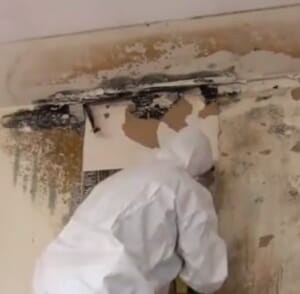When property owners find mold growing in their home or building, it can provoke a lot of stress, due to the hype going around on the internet of how it is toxic and disastrous. However, the reality of the situation is that there are different types of mold – and not all of them are toxic.
In fact, thousands of different mold species exist around the world today, with at least 1,000 that are spread throughout the United States.
This is not to say that mold in your home is not dangerous or should be ignored, rather, to put some worries at ease as soon as it is discovered. Check out these tips about black mold and how it can be removed without harming your family or causing further destruction to your building structure.
What is Toxic Black Mold?
Toxic black mold, or Stachybotrys chartarum, is a common type of fungus that can grow on building materials, especially those that are porous (drywall, paint, wood, fabrics, etc.), and are very dangerous to humans. It is called toxic black mold because it produces mycotoxins within its spores that it disperses.
Distinguishing Toxic Black Mold the Others
Knowing the difference between toxic black mold and other species is important when knowing how to approach it and the level of caution that must be taken in the removal process.
Toxic black mold can appear as a greenish-black slime, or a dry and powdery substance if there is not a lot of moisture present. In both cases, they are still dangerous and should be removed by a mold removal specialist.
Other mold species can come in all shapes, sizes, and colors, ranging from blue, orange, green, yellow, white, and even black. Their texture can be flat, bumpy, or fuzzy, depending on the species.
Nevertheless, they are able to reproduce by releasing their spores into the air when disturbed. While they are not as dangerous as black mold, they should still be treated by a mold remediation professional to avoid it from spreading further and causing health issues.
What Does Black Mold Smell Like?
An odor from black mold will usually smell musty and can also be derived from the mildew from untreated water damage. As this is a natural process for it to develop and thrive, any moisture must be removed and the building materials will need to be treated by a water damage restoration expert.
It can also be noticed if there is black mold in your HVAC system and the spores are being distributed throughout the property. This can cause the most damage and will be disastrous for your family or staff if it is not treated right away.
ServiceMaster of North Texas specializes in mold remediation and water restoration and will prevent the problem from returning in the future by completely repairing the damaged area.
Health Problems Associates with Black Mold
When humans and pets experience health problems associated with black mold, they are coming into contact with the mycotoxins that are produced by the fungus. Be mindful that the elderly, infants and those with severe allergies are at the highest risk to experiencing these health problems.
While the symptoms will depend on allergies and the species of mold, humans, and animals can experience one or more of the following issues:
- Nausea, vomiting, and/or diarrhea
- Impaired concentration or focus (memory loss is also possible)
- Migraines, tiredness, or strong headaches
- Bladder or kidney discomforts
- Mucous membrane irritation
- Significant sneezing and/or coughing (seek emergency medical attention if you are coughing up blood).
- Troubles with breathing
- Suppression of the immune system
- Itchy or red eyes, mouth, or nose
While black mold thrives in hidden areas, noticing the foul smell as soon as possible will prevent it from becoming a bigger problem in the future. If you are suspicious of it growing on your property, be sure to exercise extreme caution when scoping it out.
What Causes Black Mold and Where it Grows
Black mold, like others, can develop and thrive anywhere, but it is generally caused by the combination of moisture and an organic feeding source. When growing outdoors, it is often found on plant debris, soil, and other decomposing organic materials.
When growing inside, the spores will search for building materials that contain a sufficient source of cellulose and less nitrogen. Because porous building materials, such as wood, drywall, and paint are great providers of these nutrients, they provide a perfect environment for the fungus to thrive.
On the other hand, black mold prefers to develop in dark, hidden areas that allow it to grow undisturbed. In addition to cellulose, it will need moisture, such as an untreated water leak. Those that occur in the attic, crawlspace, basement, under floors, and inside walls.
If you are searching for black mold in any of these areas, be very careful as it can release its spores and be very dangerous if they become inhaled. Be sure to wear personal protection, such as a breathing mask, gloves, and proper eye wear.
Black Mold Removal
If you are suspicious of or have found toxic black mold in your home or building, do not hesitate to call the experts of ServiceMaster of North Texas. Our technicians are licensed, trained, and experienced to provide water damage restoration and mold remediation in any case that you have mold growing on hidden building materials containing moisture.
After the mold and water damage has been effectively treated and removed, you will start to notice a significant difference in the indoor air quality as well as relief in allergic reactions. Finally, you won’t have to worry about the harmful fungus coming back to harm your building structure or threatening the overall health of your family or staff.

